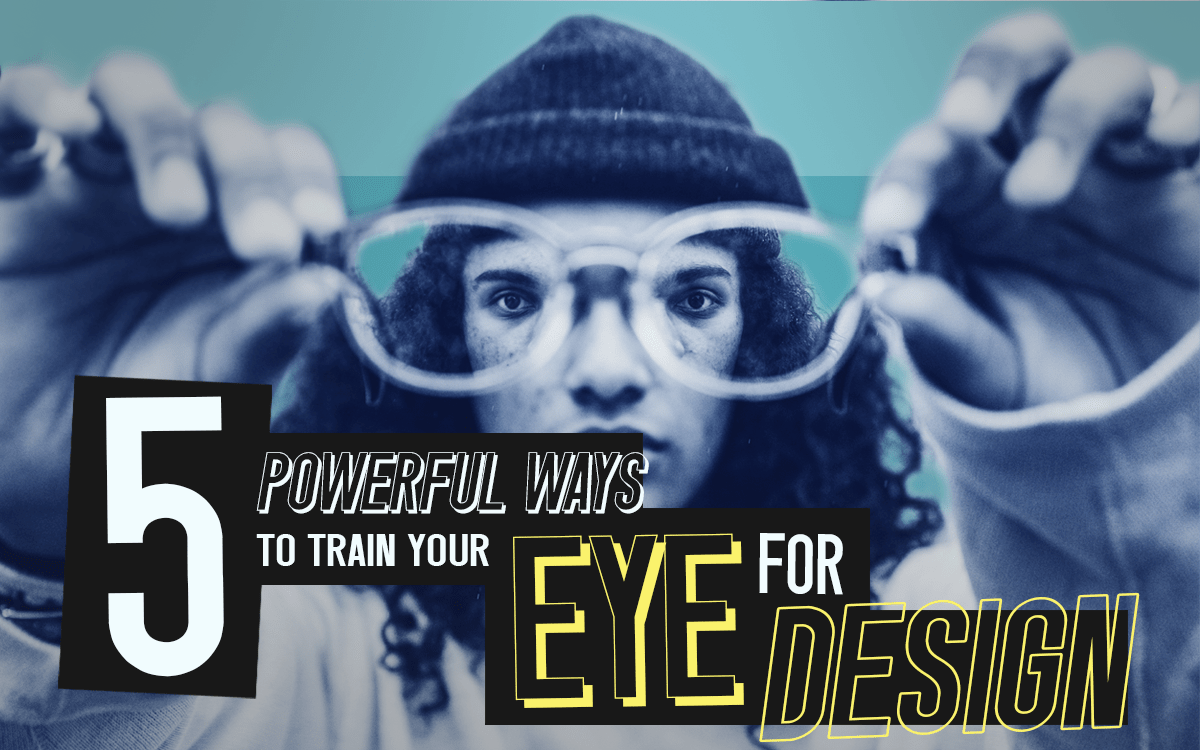5 Powerful Ways to Train your Eye for Design
Nikki Jay
- September 11, 2022

You don’t have to be a great designer to spot the OK, from GOOD and GREAT. But surprisingly, businesses are losing 70% of customer purchases because of bad user experience. Would you have a meal at a restaurant where you don’t like the ambiance?
Let’s talk about Eye for Design.
A design eye is a way how people interpret different designs and pay attention to finer details that affect the mood through color, typography, images, or style.
Developing a keen eye for design improves your design skills and affects your decisions about your designs. You’ll be able to understand how a certain design works or doesn’t, which will help you come up with better design ideas on your own.
In today’s visual age, design is more important than we think. It is unacceptable to show key information to the audience without a proper presentation, or else, the target audience will look for others that have a clean and better presentation of the information they need.
I know that some people are more gifted in terms of creativity than others, but I know some people who came from a totally different field of expertise and are already practicing their design eye to work (much better than me, so, I’m pretty confident that you can do it too!).
Here are a few basic practices that you may do to improve your eye for design.
Look Around
Design is everywhere. There are numerous things around us that you can use to develop your eye for design. First, do not limit yourself by looking only at good graphic or website designs. Sometimes, we trigger our design eye just by looking around.
For instance, a single misaligned letter from a nearby food stall signage can make us feel like something is off. Even when you walk by a misaligned road tile, although it is very obvious, it will still annoy you.

Source: Jam Press
Good design plays a big role in our community. It can be a lifesaver. That’s why our road signs were designed that way because it tells us important messages on the road. Every color used on signs or traffic lights has a meaning attached to it.
RED is used to tell motorists to stop.
GREEN gives specific road directions. It also tell us to “GO”.
YELLOW gives warnings.
BLACK and WHITE state enforceable laws, and so on.

Source: Unsplash
Imagine seeing a STOP sign on a green background. It will confuse people as it breaks the psychology behind the use of these standard colors.
Many studies about color psychology show how colors impact human behavior. You need to understand why and how different hues and shades affect our feelings and decision-making processes.
I’m not saying that you must look at every single thing for about 10 seconds to see how it was designed. What’s important is you being aware of what is good or not. Every good design around us has its message to tell. It is just a matter of how we understand and appreciate them.
Analyze other designs
Not to criticize other people’s work, but you have to learn and avoid other people’s obvious design mistakes. It will help you grow from someone who doesn’t pay attention that much to colors, alignments, and appearance; to someone who has the instinct to spot bad design elements and generate a better design idea that works.

Source: unitedgraphicdesign.com
Developing your eye for design means that you only care about aesthetics. Good graphic design is part of what you do, but you’re not just creating good graphic designs. Being a good designer means you care about the details.
Designers start with understanding the client, the product, and the target audience. They are also attentive to solving a problem at hand, then incorporating the solution into the unexpressed needs of the user.
It is important to spend time breaking down other designs. Try to understand how other designers come up with their finished work and how it solves the user’s problems.
Imagine you are a typical mom and you saw two germ-killing alcohol advertisement designs. One shows some stinky-looking cartoonish germ characters; the other one shows a family that looks protected from germs. Which product are you most likely to buy between the two?
Remember that bad graphic design often makes the message unclear.
Learn by replicating good designs
Think as if you were a good designer. You can gain inspiration and learn from notable figures in your preferred industry. Gina Greenlee said in her book, “Experience is a master teacher, even when it’s not our own.”
You may want to know how they do their work; what tools or apps they use; where they seek inspiration; what is their daily routine; and what are the past mistakes that they want to share with others. Read or watch their biographies and see what their creative journey looked like.
Also try to browse some design inspirations from sources like Dribbble, Behance, and Pinterest. Looking into these online sources might trigger a lightbulb moment for your next web design project. Some designers who say that they don’t use other people’s ideas are lying. I believe that every creative has their own way of adapting things they’ve seen. But there is however a big difference between taking inspiration from others’ work and plagiarism.

Source: tubik.arts
Inspiration is a sudden creative insight inspired by another event, person, or thought. At some point, it will be a driving force to motivate yourself to move forward.
You have to be resourceful. Collect all ideas and inspirations you’ve got to form a seamless design work of yours. If others can do it, you can do it too!
Spot the outdated
The design field is indeed a fast-evolving industry. It is very important to keep up with the current design trends. Why? Because designing is a highly competitive field. Staying up to day with current techniques and trends will give you an advantage over those who stick with what they’re used to.
Plus, knowing the modern design trends means you can offer innovative ideas to your clients. Also, trying new things while keeping your personal style will make your portfolio more unique which clients may love.
To do this, you need to get out of your comfort zone. Try to find new ways to challenge your creativity. Learn a new skill, a new tool, and new techniques. Check out some recent tutorials on YouTube, or other learning platforms like Udemy or SkillShare.
Maybe, you’ll think that is easy for me to say. But I assure you that it is very difficult to go outside your own box where you are most likely comfortable. Been there, done that. Yet, we need to somehow let go of the things that aren’t working these days.
Apply what you see
Technology is evolving and there are new tools out there that can help us achieve the design that we want with only a few steps unlike before. Take advantage of using the perfect tools to achieve perfect work.
There are so many design tools available depending on what kind of work you are doing. These tools allow creatives like you to bring their design ideas to life.
Graphic designers use Adobe Photoshop for photo editing and creating mind-bending photo artwork. They also use Adobe Illustrator to create vector graphics, logos, icons, and sketches.

Other entry-level designers and content creators use Canva to create designs that rely largely on templates. These templates are ready-made graphic designs that can be edited right away to generate clean designs quickly.
For wireframing and mockups, web designers use Figma, Adobe InDesign, MockFlow, and more.
For interior designers, there are Autodesk AutoCAD LT, SketchUp Pro, TurboCAD or Archicad.
The Eye for Design is also very helpful for non-designers who need to work with a team of designers (looking at you, fellow developers. wink!). With this, you can be a good asset to the team by working with fewer back and forths on the designs.
Final thoughts
In general, you need to put the things you observe into practice. By looking at and understanding the designs around you, your eye for design will develop significantly. Build your confidence by doing these 5 steps and you might start a design portfolio of your own soon!
Comment down how your eye for design helped you with your career!
About the Author:

